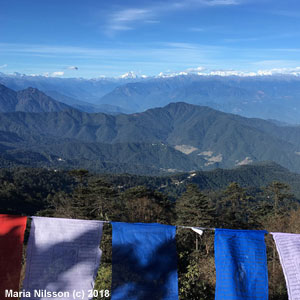Magazine | Voyages
Observer les oiseaux au pays du « bonheur brut » : séjour au Bhoutan en novembre 2017

Vue sur l’Himalaya depuis le temple de Lungchuzekha (Bhoutan) en novembre 2017.Photographie : Maria Nilsson
Introduction
Le royaume du Bhoutan est un petit pays d’Asie du Sud bordé par l’Inde au sud, à l’est et à l’ouest, et la Chine (région autonome du Tibet) au nord. Sa capitale et sa plus grande ville est Thimphou. La chaîne de l’Himalaya domine le nord du territoire. Grâce à une politique active de protection de l’environnement, les forêts (de conifères, subtropicales et tropicales de plaine et de montagne) couvrent encore plus de 65 % du territoire. Afin de limiter le nombre de touristes et contribuer au budget de l’État, chaque visiteur doit en outre payer un forfait journalier minimum de 250 dollars. Le gouvernement utilise même depuis 1972 un indicateur intitulé « Gyalyong Gakid Palzom » (Bonheur National brut) pour mesurer le bonheur et le bien-être de la population du pays.
Le Bhoutan est une destination méconnue mais d’un grand intérêt pour les observateurs, avec plus de 650 espèces d’oiseaux recensées (un chiffre certainement sous-estimé), soit près de la moitié de l’avifaune du sous-continent indien. Bien que le pays ne compte pas d’endémiques, on peut y observer des oiseaux remarquables et/ou menacés comme le Héron impérial, le Martin-pêcheur de Blyth, le Trogon de Ward, le Calao à cou roux, l’Ithagine ensanglantée, le Tragopan satyre ou le Bec-d’Ibis tibétain : c’est notamment pour observer cet étrange limicole que Julian Bell (site web : Natural Born Birder) et Maria Nilsson ont visité du 14 au 19/11/2017 les environs de Paro et de Thimphou avec la compagnie Nature Tourism Bhutan. Nous vous proposons une version française de leur rapport illustré.
Abstract
The kingdom of Bhutan is a small South Asian country bordered by India to the south, east and west, and China (Tibet Autonomous Region) to the north. Its capital and largest city is Thimphu. The Himalayan range dominates the north of the territory. Thanks to an active policy of environmental protection, forests (coniferous, subtropical and tropical) still cover more than 65% of the territory. In order to limit the number of tourists and contribute to the national budget, each visitor must pay a minimum daily fee of 250 dollars. Since 1972, the government has been using an indicator called « Gyalyong Gakid Palzom » (Gross National Happiness) to measure the happiness and the well-being of the country’s population.
Bhutan is a still unknown but of great interest destination to birders, with more than 650 species of birds recorded, which represents nearly half of the Indian subcontinent avifauna. Although there are no endemics in the country, remarkable and/or threatened birds such as Imperial Heron, Blyth’s Kingfisher, Ward’s Trogon, Rufous-necked Hornbill, Blood Pheasant, Satyr Tragopan and Ibisbill can be watched there. It is precisely to watch the strange Ibisbill that Julian Bell (website: Natural Born Birder) and Maria Nilsson visited the north-western part of the country with the company Nature Tourism Bhutan from the 14th to the 19th of November 2017. We propose you a French version of their illustrated report.
Poursuivez la lecture de cet article, en vous abonnant dès maintenant !
Découvrez les Archives d’Ornithomedia.com
Pour seulement 10,00 €TTC/an (ou 6,00 € les 6 mois)
Profitez de plusieurs centaines d’articles en accès illimité et sans aucun engagement.
Compléments
Contact
Julian Bell – Courriel : jules@naturalbornbirder.com – Blog : Natural Born Birder
À lire aussi sur Ornithomedia.com
- Synthèse du suivi 2013 de la migration automnale des rapaces à Thoolakharka (Népal)
- Bilan 2012 du suivi de la migration des rapaces à Thoolakharka (Népal)
- Première observation du Vautour indien au Népal
- Observer les vautours et les aigles dans la décharge de Jor Beed
- Un espoir pour les vautours du sous-continent indien
- Les rondes d’oiseaux
À lire aussi sur le web
- Le site web de la compagnie Nature Tourism Bhutan : www.naturetourismbhutan.com
- Un site web utile sur les hôtels du Bhoutan : www.hotel.bt
- La page consacrée au Bhoutan sur le site web France Diplomatie : www.diplomatie.gouv.fr
Ouvrages recommandés
- Birds of the Indian Subcontinent (2016) de Richard Grimmet
- Birds of India: Pakistan, Nepal, Bhutan, Sri Lanka and Bangladesh (2011) de Bikram Grewal et Sumit Sen
- Lonely Planet Bhutan (2017) de Lindsay Brown et Bradley Mayhew
- Carte Bhutan 2016 de Reise Know-How Verlag
Source
Julien Bell (2018). Gross Birding Happiness – Birding Bhutan : 14-19 November 2017. Natural Born Birder. www.naturalbornbirder.com/travel/Bhutan.html




Aucun commentaire sur ce sujet
Participer à la discussion !